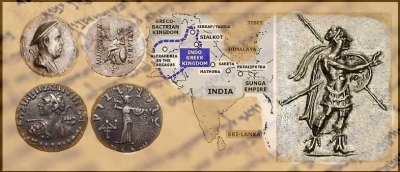
Alexander the Great came to India to see what the end of the world looked like- for the ancient Greeks believed the world was flat, and that India was at one end. He got as far as the Beas in the Punjab when his soldiers refused to carry on and forced him to turn right back. Within a few years, in 323 BC, the great man lay dead at just 32 years.
Alexander had never been defeated in battle and was worshiped like a god by his men for his military brilliance. But what would happen to the massive empire he had carved out of himself in such a short time – ranging from Greece to the Punjab?
Asia gets Hellenised
His generals carved it up amongst themselves, quarrelling and jostling for more. One of them, Seleucus, I Nicator, was particularly effective, managing to wrest nearly all of Asia for himself. Over time, the region became “Hellenised”, as the ruling class were Greeks, descendants of Alexander’s army. (To Hellenise is to make Greek in form and character and adopt Greek ideas or customs. The Hellenistic Age is a time when Greek culture mixed with the various cultures of Alexander’s Empire). The native people absorbed many bits of Greek culture including language, the arts and sciences, but also kept parts of their own culture.
Greco-Bactrian kingdom
However, eventually, as all empires must, the Seleucid Empire too began to weaken and crumble. In 250 BC, a Greek governor of Bacteria (the ancient name of the area south of the River Oxus and north of the Hindukush mountains, currently Balkh in Afghanistan), broke free and formed his own Greco-Bactrian Kingdom. India was their neighbour to the east, and there were regular exchanges between the two. Ashoka’s missionary Buddhist monks were received at their courts, and his edicts have been found as far east as Afghanistan.
Focus shifts to India
Twenty years later, and their neighbours, the Mauryas started to decline as soon as Emperor Ashoka died. Fast forward another fifty years to 180 BC, and the Greco-Bactrians were ready to try their luck in India, and started invading through its north-west borders. The first was the King Demetrius, who issued coins showing him wearing a crown shaped like an elephant’s head, which denoted his conquest of India, as nothing was more Indian than the elephant! These Bactrian-Greeks invaded again and again and various dynasties ruled over parts of India till the 1st Century AD and became known as the Indo-Greek kings of India.
More Indian than Greek
What is interesting about these rulers was that though they were oh-so-Greek, with Greek names, Greek features, Greek dress and the Greek language, many of them became very Indian over time! One of the most important Indo-Greeks was Menander I Soter “The Saviour”, who ruled a large area over the northern parts of Afghanistan, Pakistan and Punjab around 150 BC. Menander, or King Milinda as he was called here, reportedly became a committed Buddhist after he lost a heated philosophical debate with the monk Nagasena where he pitted his Western, Greek logic against the Buddhist’s Eastern, Indian reasoning! This is described in the important Buddhist text, the Milindapanha.
Menander’s coins are simply fascinating – classically Greek, with the king in a variety of warrior poses on one side, and various Greek deities like Athena, the goddess of wisdom, adorning the other. But, the inscriptions are bilingual, in Greek and the native Indian Kharoshti. Later coins begin to substitute Athena for Buddhist motifs like the elephant, bull and the eight-spoked Wheel of Dharma.
Buddhist influence
After Menander, there were a series of other Indo-Greek rulers, such as Strato I, Amyntas, Heliokles II, whom we know little about except for their coins. Many of them seem to have become influenced by Buddhism, as their coins start taking on an increasingly Indian flavour, showing both the kings themselves and the Greek gods represented on the coins, with a distinctly Buddhist hand gesture. They also refer themselves as “Dharmikasa” or “follower of the Dharma”.
Hindu influence
Other Indo-Greeks chose to become Hindu! In fact, a pillar dedicated to Garuda near Sanchi, has an inscription claiming it was raised by a Vishnu-worshipping Greek called Heliodoros, who was an ambassador or to the Shunga Kingdom, the successors to the Mauryas! A coin issued by another Greek king, Agathocles has also been found, struck with an image of Vasudeva Krishna and Balaram in Greek dress! In fact, this is the earliest depiction of Krishna found anywhere, so far.
End of Hellenistic rule
The last Indo-Greek kings were ultimately defeated by the Shakas (the Sycthians) by 10 AD and were gradually absorbed into the melting pot that is India. This ended Hellenistic rule across the world, as Egypt, the last remaining western Greek kingdom, had become a Roman colony when Augustus Caesar famously defeated the last Ptolemy ruler, Cleopatra, and her paramour Marc Antony in 31 BC. It is so intriguing to imagine the period of almost 200 years when the ancient Greeks and the ancient Indian cultures met and mingled here, in our country!
Picture Credit : Google

